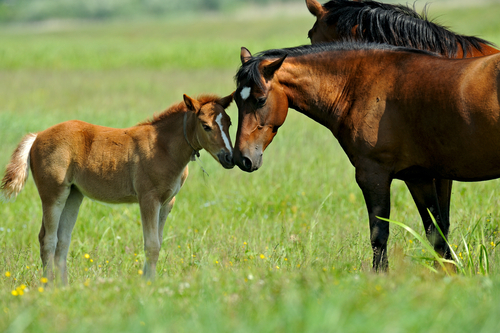The winter edition of the Oklahoma State University Equine News prepared quarterly by Dr. David Freeman, OSU Extension Equine Specialist, Department of Animal Science addresses the plight of horse owners who are having difficulty in affording the hay necessary to feed their horses.

Importance of good pasture management
The long-term effect of forage production on our pastures still can’t be predicted.
Althought his article addresses the situation in Oklahoma, it holds true for much of the country.
"Hard to imagine that spring is just a few weeks away. The relatively mild winter and the recent moisture in many areas of Oklahoma have been the saving grace of many who are trying to afford feeding of our horses.
Even so, those of us feeding hay can’t have spring arrive quickly enough. Even if you were one of the lucky or smarter ones to have purchased hay last summer, chances are that your supply is dwindling fast.
The long-term effect of forage production on our pastures still can’t be predicted. If another summer of drought andrecord breaking temperatures occurs in 2012, we can expect even less supply of affordable forage than 2011.
If moisture continues and temperatures are more toward the norm, we can expect a rebound of pasture forage. However, even if we do receive a reprieve from the drought, we still have lingering issues that need addressed:
As overgrazing of pastures is likely more prevalent than normal, expect weeds to be a big problem. While weed control may be handled partially with grazing, it will likely be a year that herbicide will be necessary. There are a lot of particulars about how best to apply herbicides in terms of timing, amounts and chemicals, so it is best to get advice from those familiar with conditions in your locale.
Cooperative Extension Educators spend a lot of their spring answering questions about weed control, fertilization and pasture management. As a general rule of thumb, herbicide treatment needs applied prior to fertilization of desirable grass species so you aren’t wasting fertilizer for growth of weeds.
Most commonly used types of herbicides in pastures are spray on ‘post emergence’ of weedy plants.
Fertilization should be directed by a soil test. Even if you haven’t yet, most will advise that is never too late for a soil test. If you follow advice for sampling, soil tests accurately report the best ratio of nitrogen, phosphorus and potassium and the best application rates for the type of forage.
Timing and rate of fertilizer are critical, and you will find differing opinions based on what your production goals for forage. A simple answer as to when is it best to fertilize is just prior to a good rain, and at the time of year that the desired plant can use fertilizer for growth.
Too early in the year, the intended grass may not be actively growing. Too little a rate and production goals won’t be reached. Too much may result in too much forage too soon, or simply a waste of money.
Grazing management will be more important than ever. Overgrazed pastures need relief from grazing. Plants should be allowed to recover from dormancy and overgrazing for several weeks during the early part of the growing season. Relief will allow for plants to grow beyond the initial stages of growth which is when the plant is most susceptible to harm from grazing and when needs are heightened for establishing root growth.
Although many of the pastures for horses are small and stocked heavily, which makes relief from grazing of pastures difficult, those that can manage grazing will receive much more return on input costs and much more total forage production for the growing season.
Even with a great turnaround of moisture and growing conditions, the effects of last year will have an affect on grass production. So, if you have small acreage and you haven’t yet considered rotational grazing during the growing season, this year may be the spring and summer to implement such practices.
So, even though the above may not be novel to most, it is time to consider what you are able to do for pasture recovery, and develop a plan that fits your condition. You can also expect hay to be in short supply this summer, and for prices to remain more characteristic of this past year as compared to years previous."
